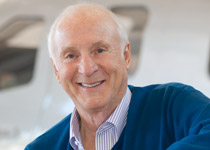Pilot reader Mark Barchenko, a private pilot from New Jersey, recently wrote to ask how I became an aviation writer. Because others have asked the same question, I decided that this would be an appropriate place to respond, so I hope that you will permit me to begin Y2K on a personal note.
When I was 20 years old and teaching ground school to help work my way through college, several students were confused by my description of the sounds made by the low-frequency, four-course ranges still used for navigation in those days (1958). My attempt to whistle the sounds didn’t help, so I told my class that I would attempt to record these sounds during my next flight and play the results at our next class meeting.
This was before the days of portable, battery-powered tape recorders. With the help of my close friend and electronic genius, Richard Somers, we set up a large AC-powered reel-to-reel tape deck in the back seat of a Cessna 170 and recorded the sounds that I had failed so miserably to describe in class. During that flight, we recorded numerous other sounds such as marker beacons; localizer, VOR, and DME identifiers; and even a ground-controlled radar approach during which a controller talked a pilot through an instrument approach by providing precise heading and sink-rate instructions.
When I played that tape in class, 19 of the 21 students wanted to buy copies. Upon hearing about this demand, another friend of mine, E.J. "Buzz" DeBardas, encouraged me to produce and market a similar phonograph record that was to be titled On Course, On the Glide Path. Writing the narration for this and subsequent 12-inch records was my first attempt at professional writing.
My small business, Aero-Progress Inc., was eventually purchased in 1963 by The Times-Mirror Co. for its subsidiary, Jeppesen.
A year later and after a long drought, the airlines began to hire pilots. The "big three" were American, Trans World, and United Airlines. I opted for TWA because it was the only one at that time with both domestic and international routes. It was the "Lindbergh Line," the "Airline of the Stars." For me, there was no other choice.
During that same year, the editor of Private Pilot magazine, Robert Said, called to tell me that he had heard and liked some of my aviation recordings. "Furthermore," he asked, "would you have any interest in writing an article for our new magazine?"
I was flabbergasted. I had barely squeaked through English composition and didn’t know the difference between a split infinitive and a dangling preposition. (I’m not sure that I do now.) But the prospect of being published had great appeal.
Said was a Pulitzer Prize nominee and knew something about writing. "It is more important to write something about which people are interested," he said, "than it is to be a proficient grammarian."
He then told me about the manuscript submitted to a New York book publisher by Robert L. Scott. "It was atrociously written, but the underlying story was so compelling that the editor believed that it would be worth the effort required to make it readable." If this editor had not seen beyond the crude grammar and punctuation, God Is My Copilot would never have become a bestseller.
Reading some of my early material makes me cringe in embarrassment. Writing, like other crafts, is a skill that improves with time. Said used to tell me repeatedly that one can become a good writer only by "reading a lot and writing a lot." But despite all of the reading and writing that I have done, I still do not consider myself a particularly good writer. Richard Bach, Ernest Gann, and Antoine de Saint-Exupéry have arranged words to form literary strands of pearls. My best does not compare to their worst, but they provide the inspiration and lofty goals to which I incessantly aspire.
No, I am not an artist in the style of the masters, but I consider myself a decent craftsman and have achieved a modicum of success. This is not because of talent but because, hopefully, I communicate information worthy of distribution.
Even after working with words for more than 40 years, my editors can confirm that I have been known to submit material barely worthy of publication, and I am sent scurrying back to the drawing board. (I pray that this is not one such piece.)
I continue writing—and hopefully improving—because it enables me to teach in a very large classroom. (Not everyone necessarily agrees with all that I profess, but that is another story.) Writing also gives me an entrée deep into the industry that I so love. How else could I have arranged to be checked out in a Grumman Widgeon (which you will read about later this year) or receive several hours of dual instruction in the space shuttle simulator by NASA’s chief astronaut (see "No Go-Arounds," April 1999 Pilot)? The rewards far outpace the agony of staring every month at a blank computer monitor and a blinking cursor when I sit down to write.
Most rewarding are the occasional letters detailing how something that I wrote might have made someone’s flying a little safer. Conversely, there are those who are spring-loaded to jump on and chastise me for my errors. One cannot write for the public and be thin-skinned. To paraphrase a printer’s axiom, "Everyone makes mistakes, but writers publish theirs."



